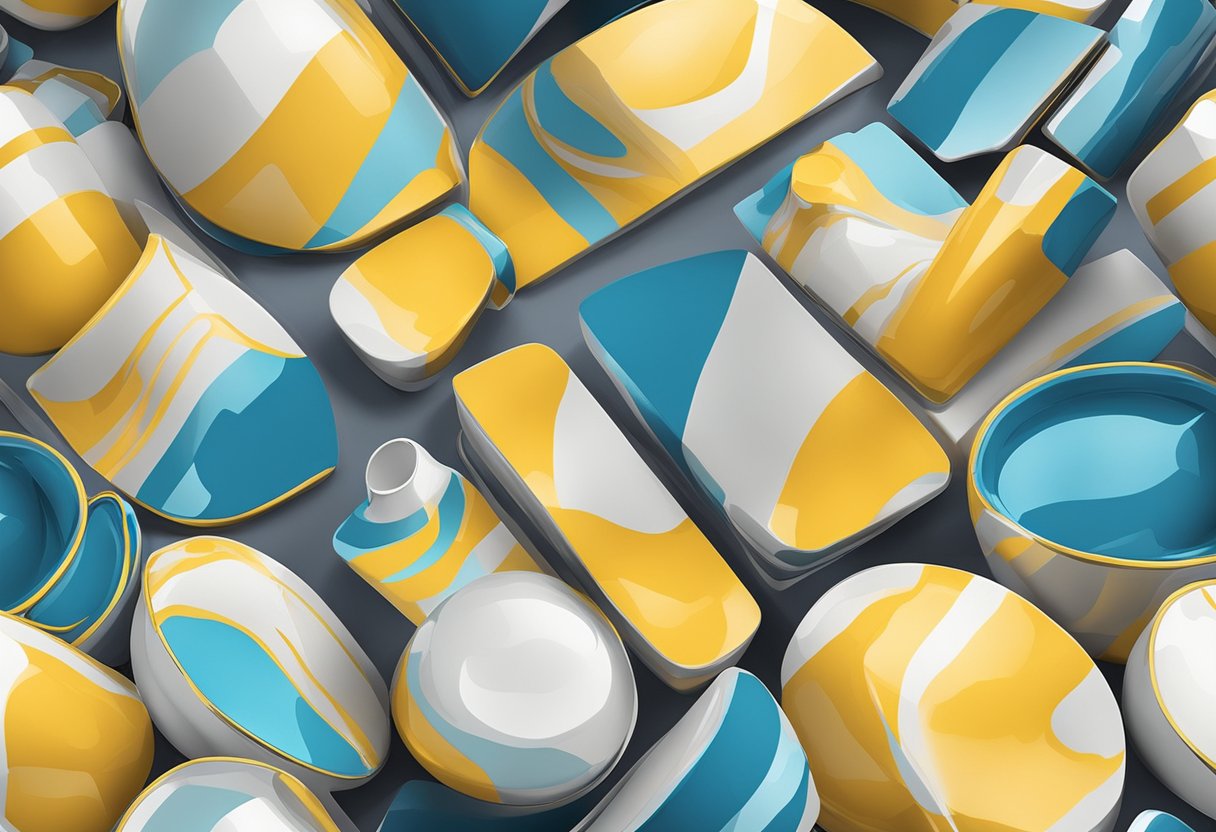What is Ceramic Coating Technology?
Ceramic coatings are becoming increasingly popular in the automotive industry due to their ability to protect a vehicle’s paint job from scratches, UV rays, and other environmental factors. But what exactly is the technology behind ceramic coatings?
At its core, ceramic coating technology involves the use of nanoparticles that create a protective layer on the surface of a vehicle’s paint. These nanoparticles are engineered to be extremely small, allowing them to bond tightly with the surface of the paint and create a durable, long-lasting layer of protection.
One of the key benefits of ceramic coatings is their ability to repel water and other liquids, making them ideal for use in wet environments. They also provide a high level of resistance to scratches and other types of damage, which can help to keep a vehicle looking newer for longer. Overall, the technology behind ceramic coatings is an innovative and effective way to protect a vehicle’s paint job and keep it looking great for years to come.
Understanding Ceramic Coatings

Ceramic coatings are a type of protective coating that is commonly used in the automotive industry. These coatings are made up of inorganic materials, which are typically liquid polymers that contain ceramic particles or nanoparticles. The ceramic particles in the coating composition are what give the coating its unique properties.
One of the main benefits of ceramic coatings is their ability to protect surfaces from damage caused by environmental factors such as UV rays, oxidation, and water. This is because the ceramic materials used in the coating composition are highly resistant to these types of damage. Additionally, ceramic coatings are known for their hydrophobic properties, which make them highly effective at repelling water and preventing water spots from forming on the surface.
Another benefit of ceramic coatings is their durability. Unlike traditional coatings, which can wear away over time, ceramic coatings are designed to last for years without needing to be reapplied. This is because the coating is made up of advanced flexible ceramics, which are highly resistant to abrasion and other types of wear and tear.
Nanotechnology plays a critical role in the development of ceramic coatings. By using nanoparticles in the coating composition, manufacturers are able to create a coating that is extremely thin and lightweight, yet still highly effective at protecting surfaces from damage. Additionally, the use of nanoparticles allows for greater control over the coating’s properties, such as its hydrophobicity and its ability to repel dirt and other contaminants.
Overall, ceramic coatings are an advanced type of protective coating that offer a range of benefits over traditional coatings. Their unique properties, including their hydrophobicity, durability, and resistance to environmental damage, make them a popular choice for use in a wide variety of applications.
The Composition of Ceramic Coatings

Ceramic coatings are made up of a combination of different materials, including silica, metal, titanium dioxide, polymers, and alumina. The primary ingredient in most ceramic coatings is silica, also known as silicon dioxide (SiO2). This compound is found in nature as quartz and sand and is a key component of glass.
In addition to silica, ceramic coatings may also contain other metal oxides, such as titanium dioxide (TiO2) and alumina (Al2O3). These oxides are added to the coating to improve its hardness, durability, and resistance to wear and corrosion.
Polymers are also often used in ceramic coatings to improve their adhesion to the surface being coated and to provide additional protection against scratches and other types of damage. These polymers may be added to the coating in the form of a liquid or as a powder.
The composition of ceramic coatings can vary depending on the specific application and desired properties. For example, coatings used in the aerospace industry may contain different ingredients than those used in the automotive industry.
Overall, the composition of ceramic coatings is carefully designed to provide a combination of properties that make them ideal for a wide range of applications. By combining different materials, ceramic coatings can offer a unique combination of hardness, durability, and resistance to wear and corrosion that cannot be achieved with other types of coatings.
The Application Process

The application process of ceramic coatings is a crucial step in ensuring the effectiveness and durability of the coating. The process involves several stages, including surface preparation, application, and curing.
Surface preparation is critical in ensuring the coating adheres to the substrate properly. The surface must be thoroughly cleaned and decontaminated to remove any dirt, grease, or contaminants that may interfere with the bonding process. The manufacturer’s instructions should be followed closely to ensure the surface is prepared correctly.
The application process can be done by professional applicators or as a DIY project. Professional applicators have the necessary equipment and expertise to apply the coating correctly, while DIY enthusiasts can purchase kits and follow the instructions provided. The application process typically involves spraying or wiping the coating onto the surface with a microfiber applicator.
After the coating is applied, it must be cured to ensure it bonds correctly to the surface. The curing process involves allowing the coating to dry and harden for a specified period, usually 24-48 hours. The manufacturer’s instructions should be followed closely to ensure the coating cures correctly.
In summary, the application process of ceramic coatings is a critical step in ensuring the effectiveness and durability of the coating. Surface preparation, application, and curing are the three stages involved in the process. The process can be done by professional applicators or as a DIY project, and the manufacturer’s instructions should be followed closely to ensure the coating is applied and cured correctly.
Benefits of Ceramic Coatings
Ceramic coatings offer a range of benefits that make them a popular choice for protecting surfaces. Here are some of the key benefits of ceramic coatings:
Protection and Barrier
Ceramic coatings provide a protective barrier that can help prevent damage to surfaces. They offer excellent wear resistance and corrosion resistance, protecting surfaces from the elements, UV rays, and other environmental factors. They also provide a barrier against dirt, dust, and other contaminants, keeping surfaces clean and looking new.
Appearance and Gloss
Ceramic coatings can enhance the appearance of surfaces, providing a high gloss finish that looks great and lasts for years. They can help restore the shine to older surfaces, making them look like new again. Ceramic coatings also offer a range of colors and finishes, allowing you to customize the appearance of your surfaces.
Durability and Longevity
Ceramic coatings are incredibly durable and long-lasting, making them an excellent investment for protecting surfaces. They offer a high level of scratch resistance, protecting surfaces from damage and wear. They also have self-healing properties that can help repair minor scratches and imperfections over time.
Hydrophobic and Self-Cleaning
Ceramic coatings are hydrophobic, meaning they repel water and other liquids. This makes them ideal for protecting surfaces from water damage and stains. They also have self-cleaning properties, making them easy to maintain and keep clean. Dirt and grime will simply slide off the surface, reducing the need for frequent cleaning.
Environmentally Friendly
Ceramic coatings are an environmentally friendly option for protecting surfaces. They are free from harmful chemicals and VOCs, making them safe for use in homes and other environments. They also require less maintenance and cleaning, reducing the need for harsh chemicals and cleaning agents.
Overall, ceramic coatings offer a range of benefits that make them an excellent choice for protecting surfaces. They provide a high level of protection, durability, and longevity, while also enhancing the appearance of surfaces and offering self-cleaning properties.
Ceramic Coatings and Environmental Impact
Ceramic coatings are increasingly being used in various industries due to their ability to significantly enhance metal surface properties such as antifouling, self-cleaning, corrosion resistance, wear resistance, oil/water separation, and biocompatibility. However, it is important to consider the environmental impact of using ceramic coatings.
One of the benefits of ceramic coatings is their ability to reduce the use of solvents and volatile organic compounds (VOCs) in the painting process. This is because ceramic coatings can be applied using a dry process, which eliminates the need for solvents. As a result, the use of ceramic coatings can help reduce the emission of harmful pollutants into the environment.
Additionally, ceramic coatings are known for their durability, which means that they do not need to be reapplied as frequently as other coatings. This reduces the amount of waste generated from the disposal of used coatings.
Furthermore, ceramic coatings can be made from environmentally friendly materials such as silica, which is abundant in nature and does not pose a threat to the environment. This makes them a more sustainable option compared to other coatings that may contain harmful chemicals.
However, it is important to note that the production of ceramic coatings can also have an environmental impact. The production process may require high temperatures and energy consumption, which can result in the emission of greenhouse gases. Additionally, the disposal of used coatings may also pose a challenge as ceramic coatings are not biodegradable.
Overall, while ceramic coatings offer several benefits, it is important to consider their environmental impact. The use of environmentally friendly materials and production methods can help mitigate the negative effects of ceramic coatings on the environment.
Maintenance and Care of Ceramic Coatings
Ceramic coatings are known for their durability and long-lasting protection against environmental factors, such as dirt, grime, and fading. However, proper maintenance and care are still necessary to ensure the coating remains in optimal condition.
To keep ceramic coatings clean, regular washing is essential. Contrary to popular belief, even with a ceramic coating, a vehicle should still be washed frequently. The two-bucket wash method is recommended, using a high-quality car wash soap and microfiber towels to avoid scratches.
In addition to regular washing, spot cleaning is necessary to remove any dirt, stains, or grime that may accumulate on the coating. A quick detail spray can be used for this purpose, but it is important to choose a product specifically designed for ceramic coatings.
Proper care and maintenance also involve protecting the coating from rock chips and wear and tear. While ceramic coatings offer excellent adhesion and molecular bonding, they are not invincible and can still be damaged by physical stresses. To prevent defects, it is recommended to avoid parking under trees or in areas with high debris.
Detailing is also an important aspect of ceramic coating maintenance. Professional detailing services can provide additional protection and help maintain the coating’s appearance for years to come. However, it is important to choose a reputable detailer with experience in ceramic coatings.
Overall, proper maintenance and care are essential for the longevity and effectiveness of ceramic coatings. While they offer excellent protection, neglecting to maintain them can lead to premature wear and damage. By following these simple steps, ceramic coatings can provide long-lasting protection and a beautiful finish for years to come.
Ceramic Coatings in Different Industries
Ceramic coatings are widely used in various industries due to their unique properties. They are known for their ability to protect surfaces from UV rays, oxidation, chemical stains, tree sap, and scratches. Ceramic coatings are used as a protective layer on exterior surfaces of cars, boats, and planes. They are also used in the oil and gas, petrochemical, steel, plastics, textile, and other industries.
Ceramic coatings are known for their hardness and mechanical properties. They are engineered to withstand extreme conditions and provide long-lasting protection. Ceramic coatings can be applied in multi-layer coatings or as a single layer. They can be applied using powder or liquid form and can be crosslinked for added durability.
In the aerospace industry, ceramic coatings are used on aerospace alloys to protect against high temperatures and corrosion. Thermal spray coating, plasma spray coating, and sputter coating are some of the methods used to apply ceramic coatings on aerospace alloys.
Ceramic coatings are also used in engineering applications to enhance the interaction between moving metal parts. They can improve the efficiency of certain manufacturing processes.
Overall, ceramic coatings offer a versatile solution for protecting surfaces in various industries. To learn more about ceramic coatings, check out the American Coatings Association and IGL Coatings websites.
Emerging Trends and Applications
Ceramic coatings have been gaining popularity in recent years due to their excellent properties such as chemical stability, oxidation resistance, and corrosion protection. As technology continues to advance, new trends and applications for ceramic coatings are emerging.
One of the emerging applications of ceramic coatings is in the automotive industry. Ceramic coatings can protect a vehicle’s paint job from damage caused by environmental factors such as sand, water spots, and stains. Additionally, ceramic coatings can provide a layer of protection against scratches and cracks, which can save car owners money in repairs.
Another emerging application of ceramic coatings is in the marine industry. Ceramic coatings can protect boats from damage caused by saltwater and other harsh environmental factors. The coating can also make it easier to clean the boat, saving time and effort.
Ceramic coatings are also being used in the construction industry to protect buildings from damage caused by weather and other environmental factors. The coating can provide a layer of protection against moisture, which can cause damage to buildings over time.
Professional ceramic coatings are becoming more widely available, making it easier for consumers to protect their belongings from damage. These coatings are typically more durable and longer-lasting than DIY coatings.
Overall, ceramic coatings have a wide range of emerging applications and trends. As technology continues to advance, it is likely that new applications for ceramic coatings will continue to emerge.









